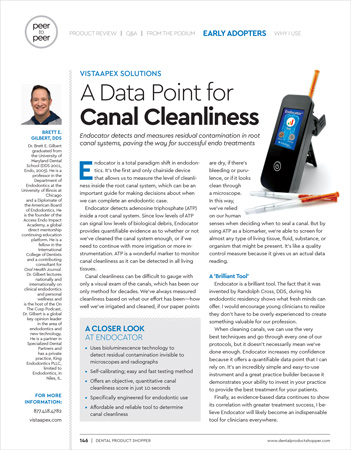A New Era in Endodontics: Dr. Brett E. Gilbert on Why the Endocator Is a “Total Paradigm Shift”

In a field where success hinges on precision, predictability, and meticulous canal disinfection, few innovations have made as significant an impact as the Endocator—the first and only chairside device capable of quantifying canal cleanliness using ATP bioluminescence. In his recent feature with Dental Product Shopper, Dr. Brett E. Gilbert spotlights how this groundbreaking tool is elevating clinical confidence and redefining endodontic decision-making.
Seeing What We’ve Never Been Able to See Before
For decades, clinicians have relied on visual cues and subjective indicators—dry paper points, absence of purulence, clean microscopy views—to determine whether a canal is ready for obturation. While these markers have guided generations of endodontists, they are inherently limited. As Dr. Gilbert notes, the challenge has always been that cleanliness inside a root canal system cannot truly be seen.
Enter ATP detection.
The Endocator measures adenosine triphosphate (ATP) levels within the canal space. ATP is present in all living tissues and viable debris. Low ATP means low biological contamination. With a quick, 10-second scan, clinicians receive an objective, quantifiable value indicating whether additional cleaning is needed.
This data-driven clarity transforms what was once a “best judgment” moment into a measurable, evidence-based decision point.
A Brilliant Innovation—Born from Fresh Perspective
One of the most compelling aspects of the Endocator’s story, highlighted by Dr. Gilbert, is its origin. The device was developed by Dr. Randolph Cross while still in endodontic residency, proving that meaningful innovation doesn’t require decades in practice—only the courage to think differently.
Dr. Gilbert praises this forward-thinking mindset, encouraging younger clinicians to imagine, invent, and push the field ahead.
Elevating Clinical Confidence and Patient Care
Even the most meticulous cleaning protocols have variability. Dentin anatomy, irrigation flow, and instrumentation challenges can differ case to case. Dr. Gilbert explains that despite following best practices, clinicians cannot always be certain a canal is ready.
The Endocator changes that.
With its simple workflow and clear data readout, clinicians gain:
✅ Higher confidence before obturation
✅ An objective “quality control” step
✅ Better communication with patients
✅ A differentiator for their practice
Patients also benefit—knowing their treatment was validated not only by expert skill but by real numbers that confirm the canal is as clean as possible.
Why Dr. Gilbert Believes the Endocator Is the Future
As dentistry continues trending toward evidence-based care, tools that provide measurable outcomes will become essential. Dr. Gilbert asserts that the Endocator’s ATP-based technology will “likely become an indispensable tool for clinicians everywhere,” especially as research consistently correlates cleanliness with long-term endodontic success.
A Simple Tool With Powerful Impact
The Endocator’s standout features include:
- Bioluminescence technology that detects contamination invisible to the eye
- A fast, self-calibrating workflow
- A 10-second canal cleanliness score
- Endodontic-specific engineering
- An affordable and reliable way to strengthen clinical decision-making
It’s more than a device—it’s a new layer of assurance in an already demanding specialty.
Final Thoughts
Dr. Gilbert’s article underscores a significant movement within endodontics: the shift toward measurable, validated treatment protocols. The Endocator empowers clinicians with data they’ve never had before—data that improves accuracy, builds trust, and enhances outcomes.
As Dr. Gilbert emphasizes, the future of endodontics will rely not only on technique, but on technology that confirms what we aim to achieve: clean canals, predictable treatments, and healthier patients.
